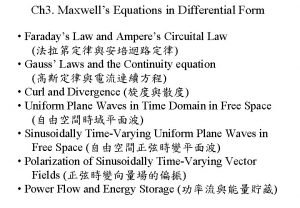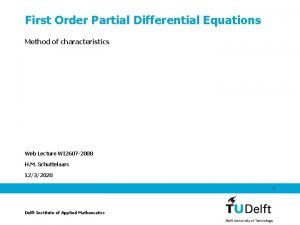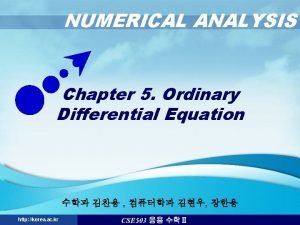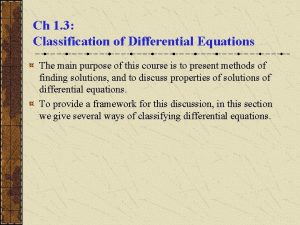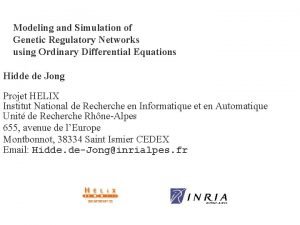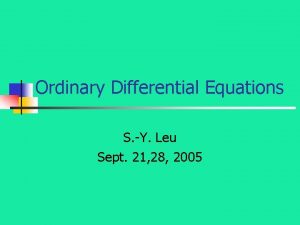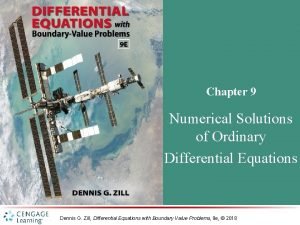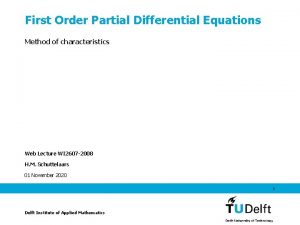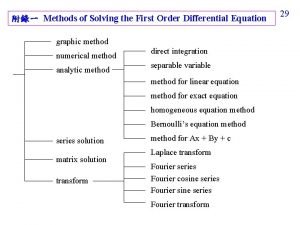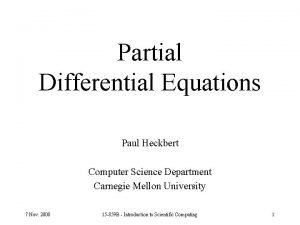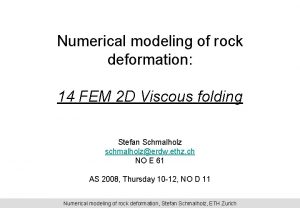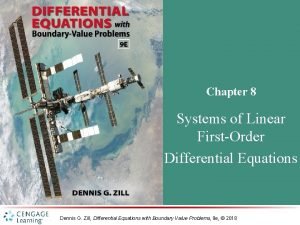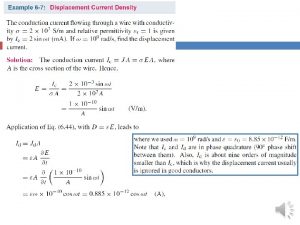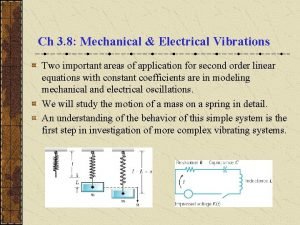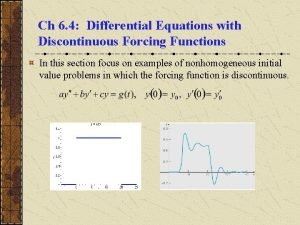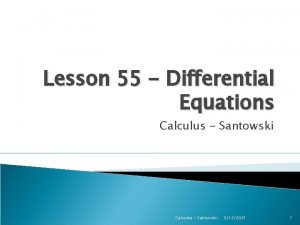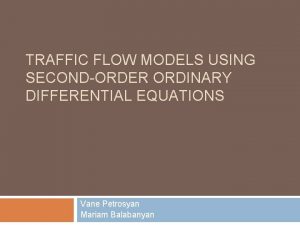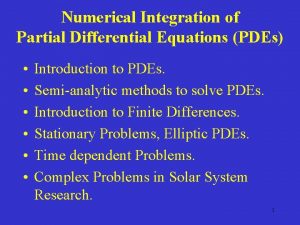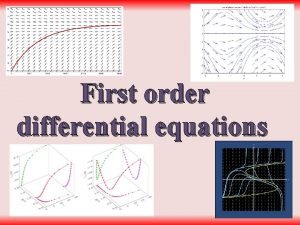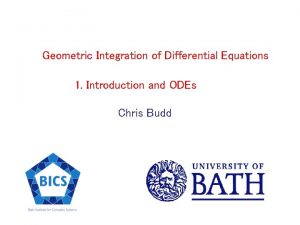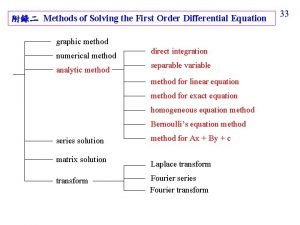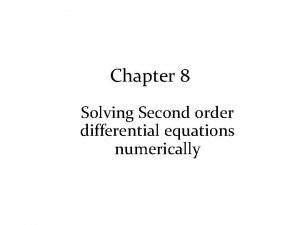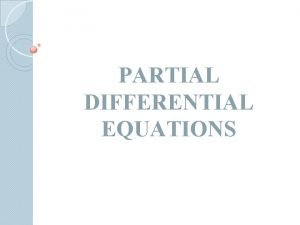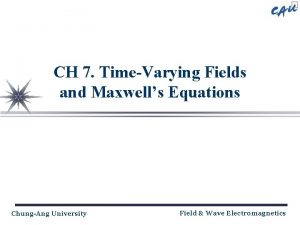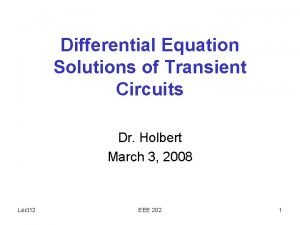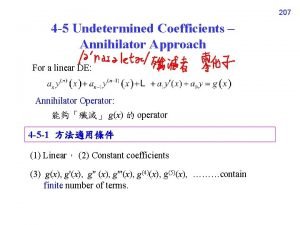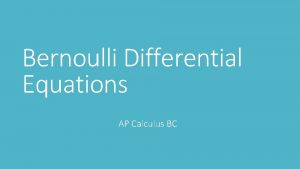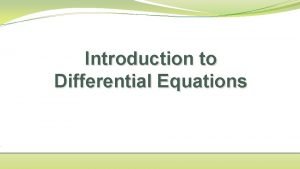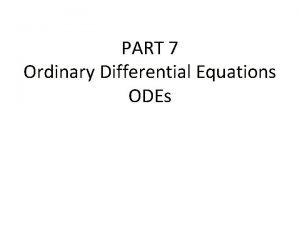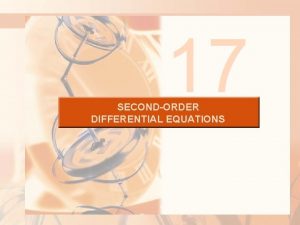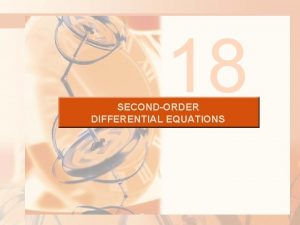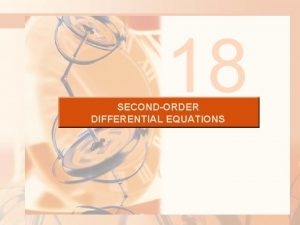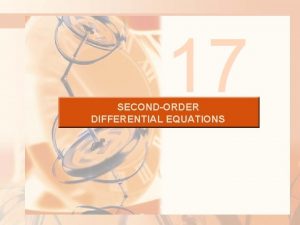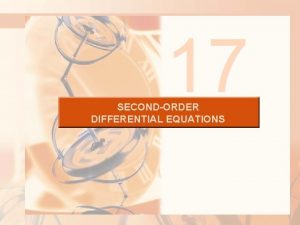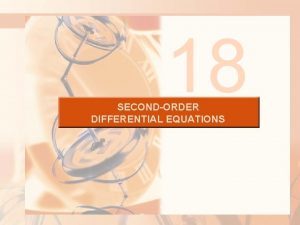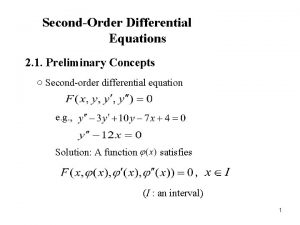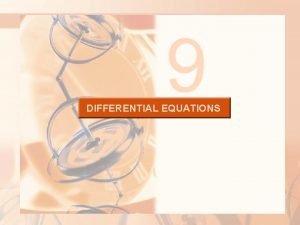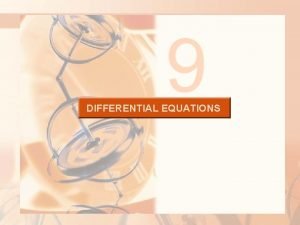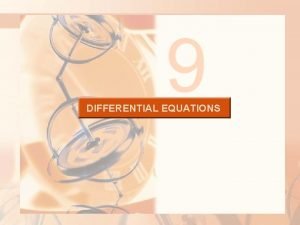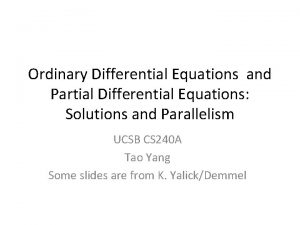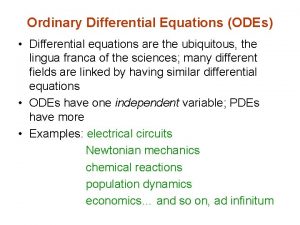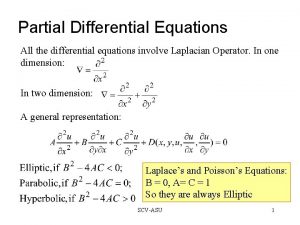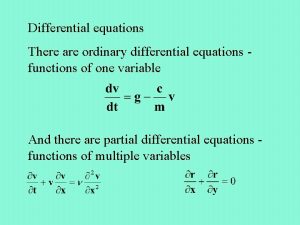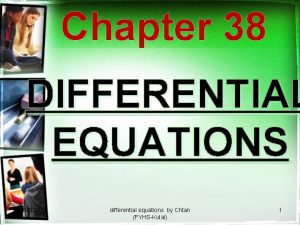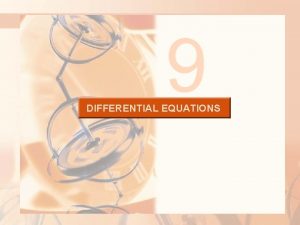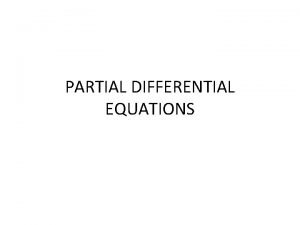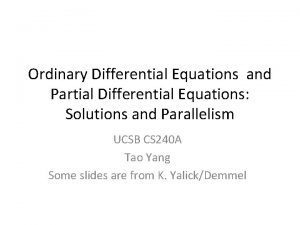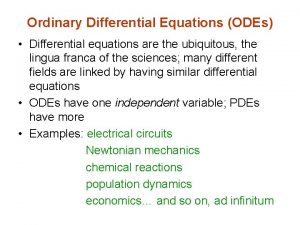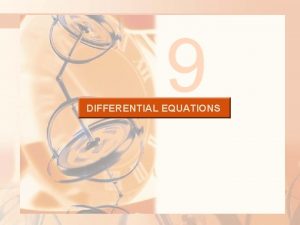Programme 26 Secondorder differential equations PROGRAMME 26 SECONDORDER


































- Slides: 34

Programme 26: Second-order differential equations PROGRAMME 26 SECOND-ORDER DIFFERENTIAL EQUATIONS STROUD Worked examples and exercises are in the text

Programme 26: Second-order differential equations Introduction Homogeneous equations The auxiliary equation Summary Inhomogeneous equations Particular solution STROUD Worked examples and exercises are in the text

Programme 26: Second-order differential equations Introduction Homogeneous equations The auxiliary equation Summary Inhomogeneous equations Particular solution STROUD Worked examples and exercises are in the text

Programme 26: Second-order differential equations Introduction For any three numbers a, b and c, the two numbers: are solutions to the quadratic equation: with the properties: STROUD Worked examples and exercises are in the text

Programme 26: Second-order differential equations Introduction The differential equation: can be re-written to read: that is: STROUD Worked examples and exercises are in the text

Programme 26: Second-order differential equations Introduction The differential equation can again be re-written as: where: STROUD Worked examples and exercises are in the text

Programme 26: Second-order differential equations Introduction The differential equation: has solution: This means that: That is: STROUD Worked examples and exercises are in the text

Programme 26: Second-order differential equations Introduction The differential equation: has solution: where: STROUD Worked examples and exercises are in the text

Programme 26: Second-order differential equations Introduction Homogeneous equations The auxiliary equation Summary Inhomogeneous equations Particular solution STROUD Worked examples and exercises are in the text

Programme 26: Second-order differential equations Introduction Homogeneous equations The auxiliary equation Summary Inhomogeneous equations Particular solution STROUD Worked examples and exercises are in the text

Programme 26: Second-order differential equations Homogeneous equations The differential equation: Is a second-order, constant coefficient, linear, homogeneous differential equation. Its solution is found from the solutions to the auxiliary equation: These are: STROUD Worked examples and exercises are in the text

Programme 26: Second-order differential equations Introduction Homogeneous equations The auxiliary equation Summary Inhomogeneous equations Particular solution STROUD Worked examples and exercises are in the text

Programme 26: Second-order differential equations Introduction Homogeneous equations The auxiliary equation Summary Inhomogeneous equations Particular solution STROUD Worked examples and exercises are in the text

Programme 26: Second-order differential equations The auxiliary equation Real and different roots Real and equal roots Complex roots STROUD Worked examples and exercises are in the text

Programme 26: Second-order differential equations The auxiliary equation Real and different roots If the auxiliary equation: with solution: where: then the solution to: STROUD Worked examples and exercises are in the text

Programme 26: Second-order differential equations The auxiliary equation Real and equal roots If the auxiliary equation: with solution: where: then the solution to: STROUD Worked examples and exercises are in the text

Programme 26: Second-order differential equations The auxiliary equation Complex roots If the auxiliary equation: with solution: where: Then the solutions to the auxiliary equation are complex conjugates. That is: STROUD Worked examples and exercises are in the text

Programme 26: Second-order differential equations The auxiliary equation Complex roots to the auxiliary equation: means that the solution of the differential equation: is of the form: STROUD Worked examples and exercises are in the text

Programme 26: Second-order differential equations The auxiliary equation Complex roots Since: then: The solution to the differential equation whose auxiliary equation has complex roots can be written as: : STROUD Worked examples and exercises are in the text

Programme 26: Second-order differential equations Introduction Homogeneous equations The auxiliary equation Summary Inhomogeneous equations Particular solution STROUD Worked examples and exercises are in the text

Programme 26: Second-order differential equations Introduction Homogeneous equations The auxiliary equation Summary Inhomogeneous equations Particular solution STROUD Worked examples and exercises are in the text

Programme 26: Second-order differential equations Summary Differential equations of the form: Auxiliary equation: Roots real and different: Solution Roots real and the same: Solution Roots complex (α + jβ): Solution STROUD Worked examples and exercises are in the text

Programme 26: Second-order differential equations Introduction Homogeneous equations The auxiliary equation Summary Inhomogeneous equations Particular solution STROUD Worked examples and exercises are in the text

Programme 26: Second-order differential equations Introduction Homogeneous equations The auxiliary equation Summary Inhomogeneous equations Particular solution STROUD Worked examples and exercises are in the text

Programme 26: Second-order differential equations Inhomogeneous equations The second-order, constant coefficient, linear, inhomogeneous differential equation is an equation of the type: The solution is in two parts y 1 + y 2: (a) part 1, y 1 is the solution to the homogeneous equation and is called the complementary function which is the solution to the homogeneous equation (b) part 2, y 2 is called the particular integral. STROUD Worked examples and exercises are in the text

Programme 26: Second-order differential equations Inhomogeneous equations Complementary function Example, to solve: (a) Complementary function Auxiliary equation: m 2 – 5 m + 6 = 0 solution m = 2, 3 Complementary function y 1 = Ae 2 x + Be 3 x where: STROUD Worked examples and exercises are in the text

Programme 26: Second-order differential equations Inhomogeneous equations Particular integral (b) Particular integral Assume a form for y 2 as y 2 = Cx 2 + Dx + E then substitution in: gives: yielding: so that: STROUD Worked examples and exercises are in the text

Programme 26: Second-order differential equations Inhomogeneous equations Complete solution (c) The complete solution to: consists of: complementary function + particular integral That is: STROUD Worked examples and exercises are in the text

Programme 26: Second-order differential equations Inhomogeneous equations Particular integrals The general form assumed for the particular integral depends upon the form of the right-hand side of the inhomogeneous equation. The following table can be used as a guide: STROUD Worked examples and exercises are in the text

Programme 26: Second-order differential equations Introduction Homogeneous equations The auxiliary equation Summary Inhomogeneous equations Particular solution STROUD Worked examples and exercises are in the text

Programme 26: Second-order differential equations Introduction Homogeneous equations The auxiliary equation Summary Inhomogeneous equations Particular solution STROUD Worked examples and exercises are in the text

Programme 26: Second-order differential equations Particular solution We have just seen that the complete solution to: is: Which contains the two constants, A and B. These two constants are arbitrary because whatever values are chosen for them, when inserted into the above equation for y it will still be a solution to the differential equation. This means, of course, that there is an infinite number of solutions to the differential equation, each one having specific values for A and B. STROUD Worked examples and exercises are in the text

Programme 26: Second-order differential equations Particular solution To select just one particular solution requires additional information and this information is provided by what are called boundary conditions that take the form of a given specific value of y and its derivative for a particular value of x. For example, if we were to impose the boundary conditions that at: we would find that: STROUD Worked examples and exercises are in the text

Programme 26: Second-order differential equations Learning outcomes üUse the auxiliary equation to solve certain second-order homogeneous equations üUse the complementary function and the particular integral to solve certain secondorder inhomogeneous equations üImpose boundary conditions to find a particular solution STROUD Worked examples and exercises are in the text
 Normal differential equation
Normal differential equation Hertz
Hertz Differential equations
Differential equations Transient solution differential equations
Transient solution differential equations Definition and classification of differential equations
Definition and classification of differential equations Ordinary differential equations
Ordinary differential equations Ordinary differential equations definition
Ordinary differential equations definition Differential equations zill solutions
Differential equations zill solutions Non homogeneous differential equation definition
Non homogeneous differential equation definition Method of characteristics pde second order
Method of characteristics pde second order First order linear differential equation
First order linear differential equation Differential equations in computer science
Differential equations in computer science Numerical methods for partial differential equations eth
Numerical methods for partial differential equations eth Mixing problems differential equations
Mixing problems differential equations Derivation of maxwell's equations in differential form
Derivation of maxwell's equations in differential form Cengage differential equations
Cengage differential equations Mechanical and electrical vibrations differential equations
Mechanical and electrical vibrations differential equations Differential equations with discontinuous forcing functions
Differential equations with discontinuous forcing functions Carrying capacity equation calculus
Carrying capacity equation calculus Traffic flow differential equations
Traffic flow differential equations Logistic differential equations
Logistic differential equations Integration of partial differential equation
Integration of partial differential equation What is a first order equation
What is a first order equation Stewart differential equations
Stewart differential equations Symplectic
Symplectic Cengage differential equations
Cengage differential equations First-order differential equations
First-order differential equations Second order differential equation
Second order differential equation Partial differential equations
Partial differential equations Derivation of maxwell's equations in differential form
Derivation of maxwell's equations in differential form Natural solution
Natural solution Differential equations variation of parameters
Differential equations variation of parameters Bernoulli equation differential equations examples
Bernoulli equation differential equations examples Order and degree of differential equation
Order and degree of differential equation Midpoint method formula
Midpoint method formula

